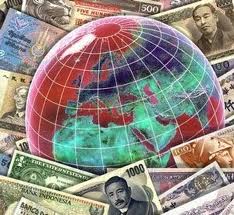GCR Historical Overview – Part 5/10
 Please be aware that no one here at the Golden Age of Gaia has the ability to advise you on financial matters.
Please be aware that no one here at the Golden Age of Gaia has the ability to advise you on financial matters.
We do not endorse or not endorse the views expressed in this booklet. Especially in this section, we do not endorse the rates cited here. However many of them do correspond with other rate statements from the past, which we also do not endorse. As far as we know, no one knows the rates for sure.
Download it here: GCR Download.
GLOBAL CURRENCY RESET (GCR) & REVALUATION OF CURRENCIES (RV)HISTORICAL OVERVIEW (EDUCATIONAL PURPOSES ONLY) 2015
FIRST BASKET CURRENCIES
Vietnam Dong (VND)
Zimbabwe Dollar (ZWR)
FROM BANKRUPTCY TO BREAKTHROUGH
Iraq Dinar (IQD)
Indonesian Rupiah (IDR)
The task of resetting all sovereign currencies back to a par gold value, countries agreed to be audited to determined who might be closest or furthest from a common gold standard. Those who were furthest away, were placed in a what’s been called the “first basket” of revaluations. Meaning, the above four currencies were grossly undervalued, and selected to redeem first at some pre-agreed international rate.
Other countries like our own United States, Japan, Switzerland, Great Britain, Germany and Australia were deemed overvalued, and placed in an opposite but similar first basket to revalue. This is why you are seeing such wild swings in value per those countries central banks and treasury currency rates.
Now some countries (Zimbabwe, Iraq, Vietnam, Indonesia) have had such unstable political and monetary histories over the past fifty years that their currencies were deemed insolvent at some point by the IMF and World Bank. Each was stripped of their international trading status, and fiscal sanctions were taken against their sovereign currencies, which equates to bankruptcy on a diplomatic level.
All four countries had to then earn the right to trade again within the international marketplace, going through years of compliance steps in order to “re-instate” their national currencies as good standing members of the global economic community. The good news all four countries ultimately accomplished this Herculean task, and as a result, their currencies are being allowed back into the global marketplace—and this time gold backed per appropriate Basel lll standards.
But if one more deeply investigates how physical currencies actually revalue and redeem, be they in the first, second or third baskets… it’s important to consider the differences between three very different public rates all within these currency—as each of these rates will be initially offered to the public, with all three eventually merging into a single sustainable and trade-able global value benchmarked by gold.
Below are projected redemption rates for each of the first basket currencies. All rates can and will change based on traditional market forces, called “floating”:
IN COUNTRY RATE: This rate exists so local currency holders can easily redeem to new gold backed currencies within the boarders of their own country. This rate is intentionally lower than other rates, as it is meant to ease citizens and existing population back into trusting their national currency as legal tender. Remember, some of these countries have been in bankruptcy for many years, which means at onetime they experienced very public bank failures. So metal coins are often used to help the emotional healing process, all be it at lower rates to counter over spending.
VND (in Vietnam) :$0.08USD
IQD (in Iraq): $3.58USD
ZWR (in Zimbabwe) : $ 0.00014 USD
IDR (in Indonesia) : TBD
INTERNATIONAL RATE: The international rate is determined by new global monetary authorities governed by BRICS Alliance members. Many would call this the “FOREX” rate, but in essence, it’s the currency’s pre-agreed upon price, consistent anywhere in the world with a monetary value pegged against the global gold standard. In the old banking system, the international rate was backed by the USD (petrol dollar); whereas in the new banking system; this rate is backed in gold per Basel 3 compliance standards. Signed Non Disclosure Agreements (NDA) are not expected to be required in order to receive an international exchange rate.
VND (outside of Vietnam) : $ 0.46 – $ 2.71 USD
IQD (outside of Iraq) : $ 3.90 – $ 8.49 USD
ZWR (outside of Zimbabwe): $ 0.04 – $ 0.14 USD
IDR (outside of Indonesia) : $ 1.05 USD +
CONTRACT RATE: This rate requires a new account contract be signed between the bank and its client. Generally, the redemption rates are higher due to length of principal holding terms and additional restrictions placed upon movement of principal. Contract rates vary greatly depending on the bank, your liquidity position and how long you’ve been a client with the bank your exchanging with. Not everyone will be offered a contract rate, but in theory everyone could receive it if prepared. NDA’s will need to signed in order to receive the higher contracted rates guaranteed.
VND (signed NDA) : $ 2.72 – $ 20.00
IQD (signed NDA) USD : $ 8.50 – $ 38.00
ZWR (signed NDA) USD : $ 0.15 – $ 0.22
IDR (signed NDA) USD : TBD
(*All in country, international and contract rates, are subject to change without notice; contract rates also limited to qualifying clients & specific disbursement pool amounts).






